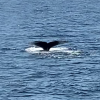Since a humpback whale lunged out of the water and landed on a small, anchored boat off the coast of Plymouth, the talk of the town among area naturalists has been: Does anyone know that whale?
It made waves across the harbor and across social media. But Laura Lilly, a naturalist for the New England Aquarium who leads whale watch tours with Boston Harbor City Cruises, said on Morning Edition she doesn’t believe it’s been identified yet — even though researchers try to identify whales as calves.
“We’re able to tell them apart by the markings on their tail when they dive down,” Lilly said. “However, this whale is in such shallow water that it often doesn't lift its tail, so you don’t have a view of that natural markings.”
The identification system helps them gather information about their lifespans and movements. It’s possible that this whale was born locally and went unnoticed until now, or that it was born elsewhere and found its way to Plymouth.
Luckily, no people were injured. But it’s hard to know how the whale is doing because it has not yet been spotted again.
“It’s kind of a miracle that no one was hurt at all, to my knowledge,” Lilly said. “And in terms of the whale, certainly it could have abrasions, cuts. It broke the front railing on the boat. So that certainly could have caused a puncture wound. There are just so many things I think that really could have happened.”
Researchers and naturalists will be keeping an eye out for any injured whales in the area.
Lilly has worked on whale watch boats for 11 years and said she has never seen a whale lunge onto a boat. But she has seen videos of collisions. In this case, she said the whale was likely lunge feeding.
During lunge feedings, whales accelerate with their mouths open, speeding through the water to catch prey like krill and small fish in their mouths. The video shows smaller fish coming up out of the water, Lilly said. That’s probably what the whale was focusing on.
“It's extremely fast, extremely powerful,” Lilly said. “And while the whale is very aware of where it’s swimming and where it’s going, certainly as it's propelling itself, once it reaches the surface it loses the complete control to be able to turn and avoid the boat.”
While the breach in Plymouth seemed to be a surprise to all involved, Lilly said she’s seen other cases in which people maneuver their boats into feeding areas.
“Sometimes the humpback whales will bubble feed, which is when they’ll exhale underwater and that creates a net of bubbles that surround the fish,” Lilly said. “You can see it as a color change in the water. But sometimes we see people drive right on top of those bubble net, and that of course puts them in danger.”
For the safety of both whales and humans, federal guidelines call for people to keep their vessels at least 100 feet away from whales.










